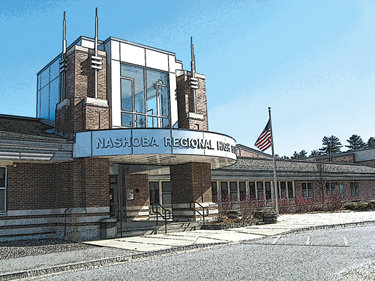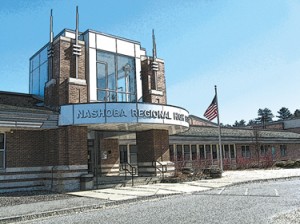
by Ann Needle 
“The most asked question at the high school to me is, what can we do about space?” said Nashoba Director of Facilities Bill Cleary. He was reporting Thursday to the Nashoba Space Task Force on what portions of Nashoba Regional High School’s structure would most need to be altered, should the district do what he termed a “major renovation.”
Cleary defined a major renovation as “any tear-down, re-build, anything adding space to the building” by about 10 to 15 classrooms. In this report to the Task Force, Cleary did not include any price estimates.
The Task Force is charged with assessing what NRHS may need to accommodate growing enrollment. Reports from teachers underline the shortage of classrooms and proper Science labs, with students using the cafeteria and auditorium area for study periods, and teachers lacking space for planning.
Cleary stressed that Facilities has just about exhausted smaller ways of creatively using existing space. Cleary emphasized that the building infrastructure is “absolutely safe.” But, he added, that a number of areas would need adjustments and upgrades in a major renovation.
For instance, while the school’s mechanical systems are fine for the current space, Cleary acknowledged many Task Force member’s complaints that the HVAC system is running too hot or too cold in many areas. NRHS’s Mary Marotta reported that the hallway starting at the Academic Support Center becomes “freezing cold” when approaching the Media Center. “We dress in layers.”
As to why some areas deal with sputtering HVAC, Cleary explained it is a “run issue” — the pipes have to run over too big of a space to deliver heat or AC efficiently. He added that a bigger building would likely call for an added mechanical system.
Throughout the building, Cleary said there are places where the systems aren’t even hooked up properly, with some curious results — such as his recent discovery that the notoriously stale air in the gym locker rooms was actually coming from the gym (which promoted gasps and wrinkling noses across the Task Force).
Superintendent Michael Wood noted that the HVAC situation is serious enough that the district will likely incorporate some repairs into its ongoing capital plan, whether or not the high school is expanded. And, though it could be expensive, an engineering firm could evaluate the situation effectively and offer solid recommendations for repairs, Cleary noted.
In another oddity that would likely change with a bigger building, Cleary explained that the well is, literally, located inside the walls of the building, in the basement underneath the loading dock sidewalk. When the water pump failed last year, getting to the well meant “we had to saw through it.” Cleary added that mentions to the Dept. of Public Works about moving the well didn’t seem to prompt concern. However, the Task Force’s Mark Jones of Stow cautioned, “The people in our town have had a different experience with wells and the DPW.”
New construction also would mean an upgrade to the electrical system, along with an energy audit, Cleary said. For now, the original system from 1961 is going strong, with some upgrades in 1999. He mentioned that the district is considering solar options, though the aging roof may not support the current products on the market. And, despite some recent repairs, the roof will need more work over the next 10 years, he added.
Where to Expand
In recommending where to add new space, Cleary pointed to the area between the gym/auditorium, and the cafeteria and classrooms (left of the entrance when facing the building). This would bring NRHS from 190,000 sq. ft. to 320,000 sq. ft., comfortably exceeding the state’s recommendation of 272,000 sq. ft. for schools with NRHS’s population, he explained.
For additional parking, Cleary recommended revamping the grassy area in front of the school, bordering Rte. 117. However, he mentioned that the leaching field (front left when facing the school) may need to be moved.
The remainder of the Task Force meeting was devoted to feedback on the draft Task Force Interim Report, presented by Bolton’s Bob Czekanski. Though Czekanski is still working on the meeting’s edits for the final Interim Report — to be presented at the Feb. 5 meeting — the Task Force agreed on the issues to be covered. These include the effect lack of space has on whether students are getting a full course load, teacher collaboration, and quality of instruction. Another topic the Task Force agreed should be looked at is whether the space shortage influences the courses offered.
In this case, Czekanski reiterated his remark from the December Task Force meeting that NRHS doesn’t seem to have “curriculum goals” guiding the types of classes to be offered, such as more Arts or Math — and could determine the type of space to be added.
Also, the Task Force agreed with Czekanski that he should meet with NRHS Principal Dr. Parry Graham and other high school staff to pinpoint the precise space needs for bringing the Science labs up to state standards.